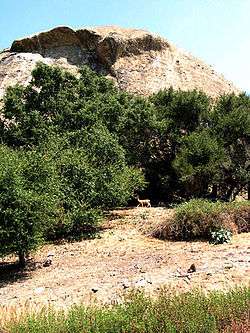Garvanza, Los Angeles
Coordinates: 34°07′07″N 118°10′45″W / 34.118569°N 118.179237°W
.jpg)

1940.jpg)
Garvanza is a neighborhood in northeast Los Angeles bordered by Highland Park to the west, South Pasadena to the east and Pasadena to the north.
History
The town of Garvanza was originally part of the Rancho San Rafael, owned by Jose Maria Verdugo. Its name comes from the fields of garbanzo beans that once flourished in the area.[1] Andrew Glassell and Albert Beck Chapman bought the land in 1869. Glassell and Chapman sold the land to Ralph and Edward Rogers, real estate developers and brothers. In 1886 the Rogers brothers subdivided the land and began to sell lots in what they called the "Town of Garvanza".[2]:7 The town was annexed by the city of Los Angeles in 1899.[3]
Garvanza was the site of the Pisgah Home mission.[4]
Garvanza was served by Henry Huntington's Los Angeles Railway (LARY) as early as 1902, and the LARY had a direct line from Garvanza to Downtown Los Angeles by 1904.[5]:84 By 1907, Huntington had extended the Garvanza line in two directions: along York Blvd. and along North Figueroa Street.[5]:85
Two bridges connecting Los Angeles and South Pasadena originate in Garvanza. One, the Los Angeles and San Gabriel Valley Railroad railroad bridge spanning the Arroyo Seco, was first built in 1885,[2]:16 and has been rebuilt twice since then. The York Boulevard bridge over the Arroyo Seco Parkway, one of the most picturesque to span the Arroyo Seco, was built to replace a small wooden toll bridge that became too rickety to support the ever increasing traffic between South Pasadena and Los Angeles. The old toll house still exists on the South Pasadena side.
The Judson Studios, which created much of the stained glass that graced Craftsman and Mission structures in Southern California, have been located in Garvanza since 1911.[6]
Garvanza, along with South Pasadena and Pasadena, is generally considered to be the birthplace of the Arts & Crafts movement in Southern California.[7]
Garvanza had lost its identity as a neighborhood by the 1940s. It was, however, revived through the efforts of the Garvanza Improvement Association and the Highland Park Heritage Trust in the 1990s and the city of Los Angeles officially bestowed the name "Garvanza" on the area in 1997.[2]:7 Garvanza is incorporated into the City of Los Angeles Highland Park-Garvanza HPOZ (Historic Preservation Overlay Zone) Preservation Plan area adopted by the Los Angeles City Council December 9, 2010.[8]
References
- ↑ laist The Neighborhood Project: Garvanza
- 1 2 3 Charles J. Fisher; Highland Park Heritage Trust (22 September 2010). Garvanza. Arcadia Publishing. ISBN 978-0-7385-8120-0. Retrieved 24 May 2013.
- ↑ Federal Writers Project of the Works Project Administration (6 March 2011). Los Angeles in the 1930s: The WPA Guide to the City of Angels. University of California Press. p. 408. ISBN 978-0-520-94886-0. Retrieved 24 May 2013.
- ↑ History of Christ Faith Mission/Old Pisgah Home, Christian Faith Mission, retrieved 28 May 2013
- 1 2 William B. Friedricks (1992). Henry E. Huntington and the creation of southern California. Ohio State University Press. p. 84. ISBN 978-0-8142-0553-2. Retrieved 24 May 2013.
- ↑ "Began near Plaza: Judson Studios honored on 75th anniversary" (PDF). Highland Park News-Herald. June 24, 1973. Retrieved 24 May 2013.
- ↑ The Neighborhood Project: Garvanza, LAist, retrieved 28 May 2013
- ↑ Highland Park-Garvanza HPOZ Preservation Plan, Including Garvanza, Highland Park, Montecito Heights and Mount Angelus Neighborhoods, City of Los Angeles, Office of Historic Resources, December 9, 2010, retrieved 28 May 2013
External links
 Media related to Garvanza, Los Angeles at Wikimedia Commons
Media related to Garvanza, Los Angeles at Wikimedia Commons

